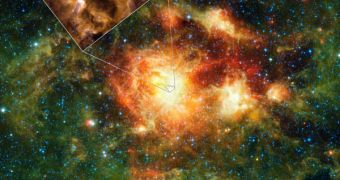The Wide-field Infrared Survey Explorer (WISE) telescope launched less than two months ago, but it's already sending back viable scientific data. Having already discovered its first asteroid, as well as the first comet, the instrument has also provided mission controllers with sufficient dataset to create the first processed images of the mission. They feature a number of space objects, including the nearby Andromeda galaxy, a stellar nursery, another comet, and a very distant galaxy cluster, featuring hundreds of members. WISE began investigating the skies in infrared wavelengths on January 14, 2010, Space reports.
Though you may think that a telescope which has been online for little more than a month only sent back a handful of photos, this isn't the case with this mission. Thus far, the telescope transmitted more than 250,000 raw images of the Universe, in very sensitive infrared wavelengths. The goal of the mission is to conduct a survey of the entire visible Universe in these portions of the electromagnetic spectrum. Over the course of its nine months of operations, the instrument will scan the entire sky one and a half times, and experts hope that this will be enough to collect all the needed data.
“WISE has worked superbly. These first images are proving the spacecraft's secondary mission of helping to track asteroids, comets and other stellar objects will be just as critically important as its primary mission of surveying the entire sky in infrared,” says the NASA Headquarters associate administrator for science missions, Ed Weiler, from Washington DC. One of the most beautiful photographs that the telescope sent back was of the stellar nursery called NGC 3603, which is located in the Carina spiral arm of the Milky Way, some 20,000 light-years away from Earth.
“All these pictures tell a story about our dusty origins and destiny. WISE sees dusty comets and rocky asteroids tracing the formation and evolution of our solar system. We can map thousands of forming and dying solar systems across our entire galaxy. We can see patterns of star formation across other galaxies, and waves of star-bursting galaxies in clusters millions of light years away,” says WISE project scientist Peter Eisenhardt, from the NASA Jet Propulsion Laboratory (JPL), in Pasadena, California.

 14 DAY TRIAL //
14 DAY TRIAL //